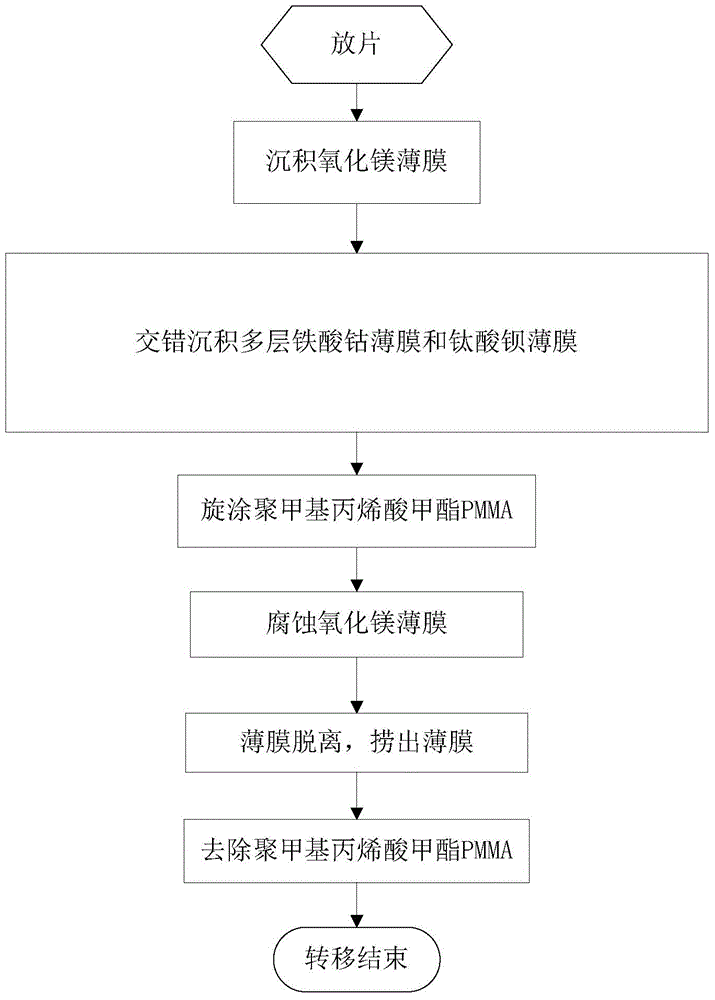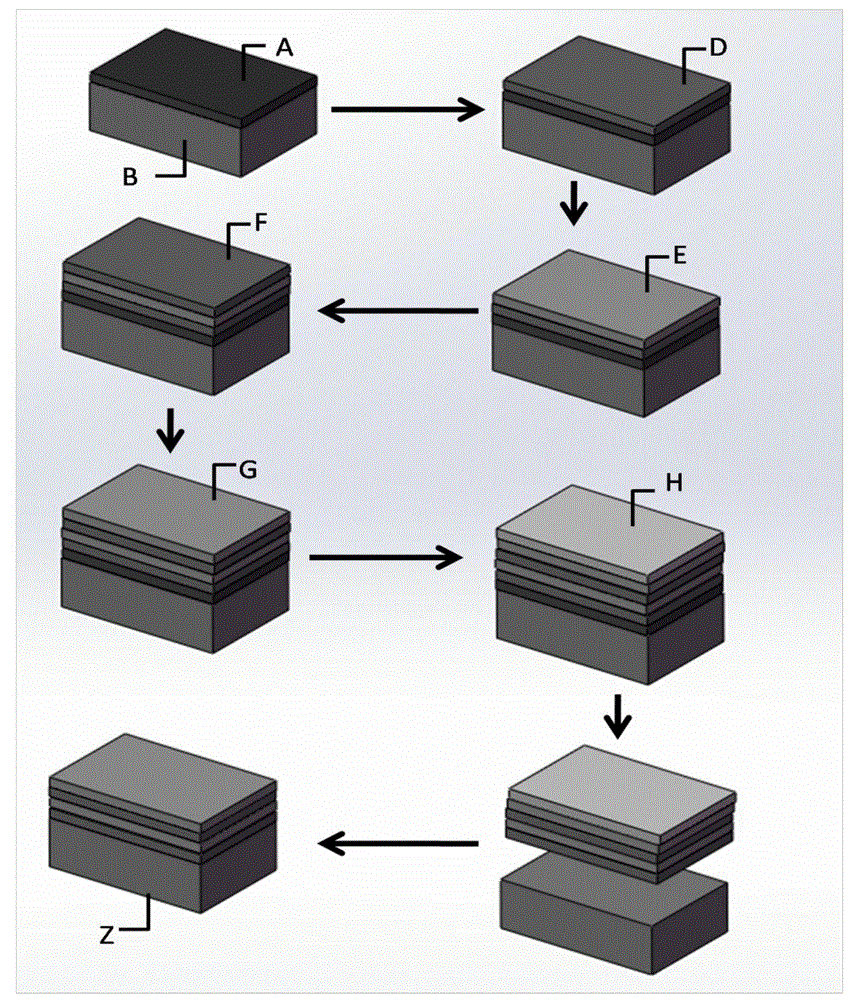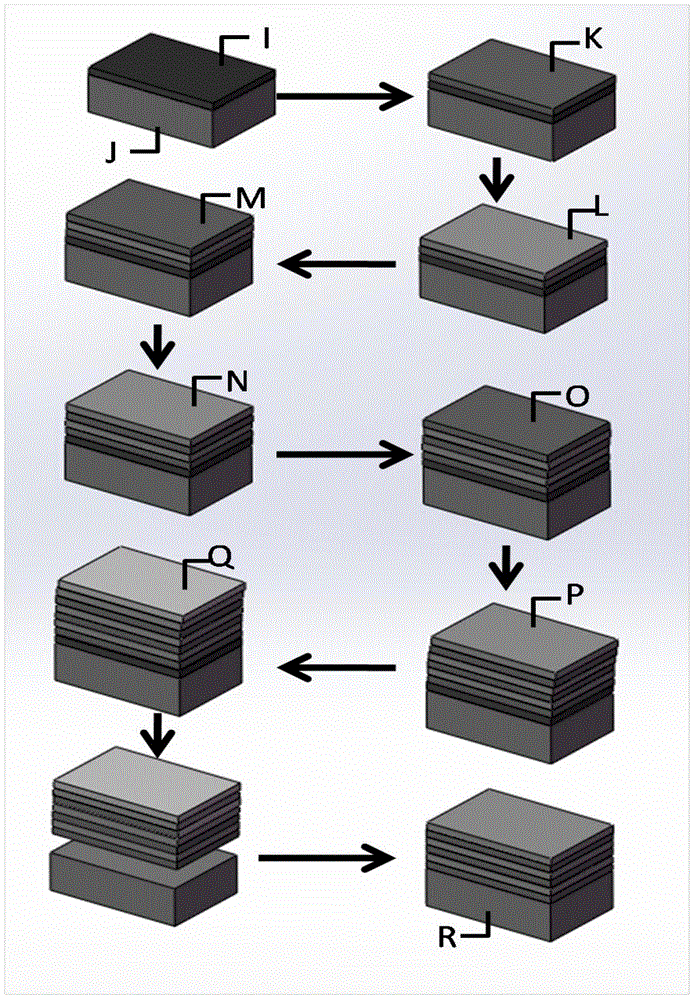Method for preparing and transferring multilayer barium titanate and multilayer cobalt ferrite magnetoelectric composite film
A magnetoelectric composite and barium titanate technology, which is applied in the field of microelectronics, can solve problems such as leakage and influence on magnetoelectric coupling, and achieve the effect of preventing cracking
- Summary
- Abstract
- Description
- Claims
- Application Information
AI Technical Summary
Problems solved by technology
Method used
Image
Examples
Embodiment 1
[0060] Example 1: A four-layer self-supporting magnetoelectric composite film with a thickness of 60 nm was prepared.
[0061] refer to figure 2 , the implementation steps of this example are as follows
[0062] Step 1, growing a magnesium oxide film on a C-plane sapphire substrate.
[0063] 1.1) Put the sapphire substrate, magnesium oxide target, barium titanate target and cobalt ferrite target on the C side into the reaction chamber of the pulsed laser deposition system, and vacuum the reaction chamber until the vacuum degree reaches 4*10 -6 Below mbar, then feed oxygen into the reaction chamber to maintain the oxygen pressure in the reaction chamber at 5*10 -3 mbar;
[0064] 1.2) Turn on the laser switch and set the energy density of the laser to 4J / cm 2 The sum frequency is 3Hz, the temperature of the substrate is set at 600°C, and the magnesium oxide target is burned 10,000 times by the laser beam to generate magnesium oxide plasma, which moves to the C-plane sapphir...
Embodiment 2
[0082] Example 2: Preparation of a four-layer self-supporting magnetoelectric composite film with a thickness of 90 nm.
[0083] refer to figure 2 , the implementation steps of this example are as follows
[0084] Step 1, growing a magnesium oxide film on a C-plane sapphire substrate.
[0085] 1a) Put the sapphire substrate, magnesium oxide target, barium titanate target and cobalt ferrite target on the C side into the reaction chamber of the pulsed laser deposition system, and vacuum the reaction chamber until the vacuum degree reaches 4*10 -6 Below mbar, then feed oxygen into the reaction chamber to keep the oxygen pressure in the reaction chamber at 0.01mbar;
[0086] 1b) Turn on the laser switch and set the energy density of the laser to 4J / cm 2 The sum frequency is 4Hz, the temperature of the substrate is set to 650°C, and the magnesium oxide target is burned 13,000 times by the laser beam to generate magnesium oxide plasma, which moves to the C-plane sapphire substra...
Embodiment 3
[0104] Example 3: Preparation of a six-layer self-supporting magnetoelectric composite film with a thickness of 180 nm.
[0105] refer to image 3 , the implementation steps of this example are as follows
[0106] In the first step, a magnesium oxide film is grown on a C-plane sapphire substrate.
[0107] First, put the sapphire substrate, magnesium oxide target, barium titanate target and cobalt ferrite target on the C side into the reaction chamber of the pulsed laser deposition system, and vacuum the reaction chamber until the vacuum degree reaches 4*10 -6 Below mbar, then feed oxygen into the reaction chamber to keep the oxygen pressure in the reaction chamber at 0.1mbar;
[0108] Then, turn on the laser switch and set the energy density of the laser to 4J / cm 2 The sum frequency is 5Hz, the temperature of the substrate is set to 700°C, and the magnesium oxide target is burned 15,000 times by the laser beam to generate magnesium oxide plasma, which moves to the C-plane s...
PUM
| Property | Measurement | Unit |
|---|---|---|
| thickness | aaaaa | aaaaa |
| thickness | aaaaa | aaaaa |
| thickness | aaaaa | aaaaa |
Abstract
Description
Claims
Application Information
 Login to View More
Login to View More - R&D
- Intellectual Property
- Life Sciences
- Materials
- Tech Scout
- Unparalleled Data Quality
- Higher Quality Content
- 60% Fewer Hallucinations
Browse by: Latest US Patents, China's latest patents, Technical Efficacy Thesaurus, Application Domain, Technology Topic, Popular Technical Reports.
© 2025 PatSnap. All rights reserved.Legal|Privacy policy|Modern Slavery Act Transparency Statement|Sitemap|About US| Contact US: help@patsnap.com



